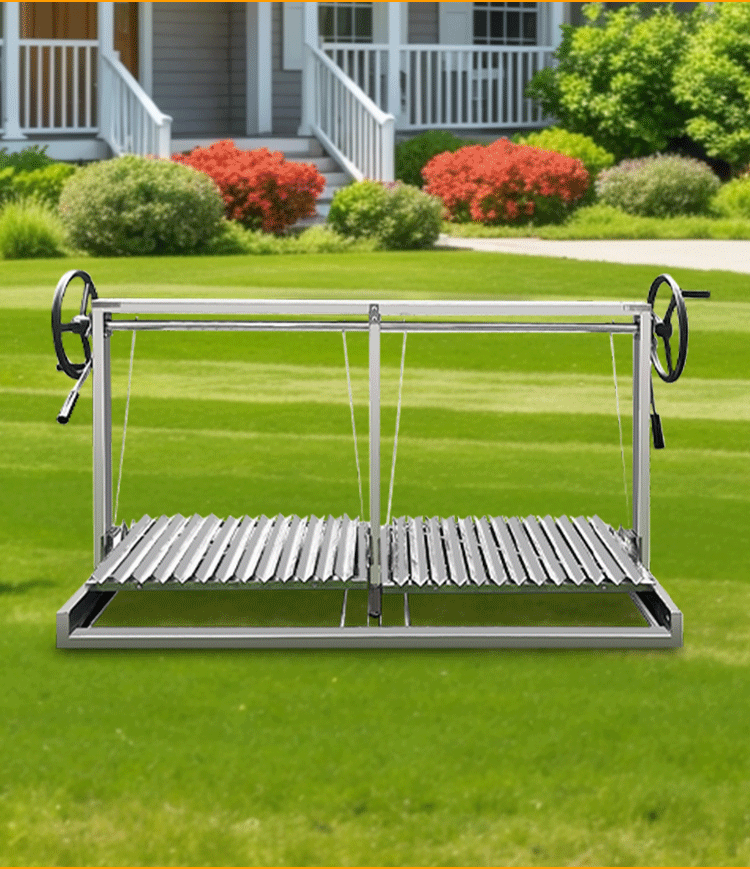Evaluating Grill Size and Cooking Area Needs
Backyard Space Considerations
Picking out a grill starts with looking at how much room we actually have in our backyard. For folks with smaller spaces, going with something compact makes sense. These grills still pack plenty of punch but don't take up too much ground space. On the flip side, those lucky enough to have big backyards can go all out with bigger setups. Some models come with built-in countertops or even little storage areas right next to them. We've seen neighbors with these fancy systems where they can cook, prep food, and store utensils all in one spot. Good planning about where everything goes really matters though, particularly during parties or family get togethers. People need space to move around comfortably while others are cooking, otherwise everyone ends up bumping into each other trying to grab condiments or check on the burgers.
Cooking Surface Dimensions
When thinking about how big a cooking surface should be, it really comes down to who usually gathers around the table. Most folks find that a grill capable of handling around 18 burgers works just fine for those weekly family dinners. But throw a bigger bash with friends over and suddenly that number jumps to closer to 30 burgers worth of space. Looking at what people actually eat tends to give better clues about proper sizing too. Someone who cooks for four might need less room than someone feeding a crowd regularly. Getting this right makes all the difference when it comes to enjoying the whole grilling experience without constantly running back and forth to flip food.
Portability vs. Permanent Installation
When choosing between a portable grill and something fixed in place, folks usually look at what matters most to them - mostly about being able to move things around versus having something solid. Portable models are great because they can be taken anywhere, which makes sense for backyard parties or when space is tight in storage areas after summer ends. Permanent grills tend to stay put though, giving cooks a stable platform year round. Plus, many homeowners find that adding a built-in grill boosts curb appeal and might even raise the home's market value. Ultimately it comes down to how people actually plan to use their equipment. Some love the freedom of moving their grill wherever needed while others prefer knowing exactly where theirs will be whenever they want to fire it up again.
V-Grate Design and Adjustable Height Mechanisms
Benefits of V-Shaped Grates
Those V-shaped grates found on traditional Argentine grills give serious advantages to anyone who loves grilling. The way they're shaped lets extra fat drip off the meat while still keeping it close enough to the heat source so flavors develop properly. Nick Carrera from Urban Asado says these V-grates really help prevent those pesky flare ups because they direct the grease away from the flames, so people don't have to constantly worry about their food catching fire. What's cool too is how all that oil and fat collects in a special drip pan underneath. Some folks actually save this stuff to baste their meats later on. And speaking of cooking results, the bigger surface area of these V-grates means better searing happens naturally. That's why serious grillers consider them almost mandatory if they want to cook something that tastes amazing and looks great on the plate.
Mastering Heat Control with Adjustable Heights
The ability to adjust height on a grill makes temperature control much easier when cooking outdoors. When someone wants to get those perfect grill marks or cook something evenly, being able to move the grate up and down really matters. Put the meat right above the fire for fast searing, maybe some steaks or burgers. Lift it higher if slow cooking is needed, letting flavors build over time like with ribs or brisket. According to Nick Carrera who knows his stuff about grilling techniques, this kind of control takes what could be guesswork out of barbecue. Newcomers find it simpler to manage temperatures without constantly checking everything. Once folks learn how these adjustments work, they start seeing better outcomes from their backyard cookouts consistently.
Drip Management for Flavorful Results
Good drip management really makes a difference when it comes to bringing out the best flavors in grilled food while keeping smoke at bay. When we talk about systems that catch those drippings, they actually make a big impact on sauces and marinades, something folks love in Argentine cooking traditions. Getting those drippings off the grill surface helps cut down on smoke production that could mess with the nice smoky flavor people want from their barbecue. Managing drips this way gives better tasting results and means less work cleaning up after cooking, so overall grilling becomes more enjoyable without all the fuss.
Fuel Type Selection: Wood vs. Charcoal
Authentic Wood-Fired Flavor Profiles
Grilling over wood gives food this amazing range of flavors that just can't be replicated any other way, which is why so many serious grillers love doing it. When folks fire up different woods like oak, hickory, or even sweet maple, each one leaves its own signature taste on whatever gets cooked. Take Argentina for instance where asados are practically national religion. Their pitmasters swear by mesquite or eucalyptus because they give meat this bold smoky kick that regular charcoal just cant match. The smoke from various woods changes how food tastes too. Some woods create that light peppery note while others add sweetness or earthiness depending on what's being grilled. Even professional chefs talk about how wood brings out layers of flavor that most people never get when using gas or electric grills. For anyone who wants to take their backyard cooking to the next level, experimenting with different woods opens up a whole world of flavor combinations nobody else at the table will forget.
Convenience of Charcoal Grilling
Most people find charcoal grilling convenient and easy to get into, which explains why it appeals to both beginners and seasoned grill masters alike. One big plus of charcoal is how well it holds steady temps during long cooks. When folks set up their coals properly, they can create different heat areas on the grill - some spots super hot for searing, others cooler for slower cooking. A lot of barbecue lovers swear by charcoal because it's just so straightforward to work with. They say nothing beats those classic smoky flavors that come from real charcoal without all the hassle. According to Food & Wine magazine, charcoal burns hotter and cleaner than propane does, giving food deeper taste profiles. That's probably why so many serious grillers keep coming back to charcoal year after year despite all the newer options available now.
Hybrid Fuel Systems for Flexibility
Hybrid grill systems offer something special for anyone who loves to cook outdoors. They let people use both wood and charcoal together, which opens up all sorts of possibilities when it comes to different kinds of grilling. The real advantage here is being able to swap between fuels based on what happens to be lying around or what kind of taste someone wants in their food. Let's face it, sometimes we just don't have enough charcoal left but still want that smoky flavor from wood chips. Hybrid grills also save money in the long run while being better for the planet too. People who own these types of grills report saving cash because they can control exactly how much fuel gets burned during each cook session. For serious barbecue enthusiasts looking to experiment with flavors without breaking the bank, these mixed fuel systems definitely deserve consideration over traditional single fuel options.
Assessing Build Materials for Durability
Stainless Steel vs. Cast Iron Comparison
Picking between stainless steel and cast iron grills really comes down to three main things: how long they'll last, how much work they need, and how well they hold heat. Stainless steel models stand out because they don't corrode easily and basically take care of themselves, which explains why so many people grab these when they want something that will stick around for years outside. Cast iron tells a different story though. These babies retain heat like nothing else, giving food that perfectly even cook every time, but come with a catch they need regular oiling to stop rust from setting in. The numbers back this up too most good stainless steel grills should see at least ten years of service if looked after properly, while cast iron might need more attention day to day but delivers consistent results that serious cooks love. At the end of the day, what matters most depends on whether someone wants to spend extra time maintaining their gear or prioritize getting great heat distribution without all the fuss.
Weather Resistance for Outdoor Use
When it comes to outdoor grills, picking materials that can handle the weather really matters if they're going to last through all sorts of conditions. Stainless steel does pretty well at fighting off rust and general wear and tear, which helps keep grills looking decent even after exposure to rain or snow. Many manufacturers also apply different kinds of coatings like powder coating to boost how long the grill lasts. These treatments help protect against things like sun damage and rust spots. According to some data, grills with these special coatings tend to perform much better over time when placed in different climate zones than ones without any protection whatsoever. For anyone wanting their backyard cooking setup to stay functional and attractive for years, spending a bit extra on quality materials pays off in the long run.
Long-Term Maintenance Requirements
Keeping a grill in good shape really matters if someone wants it to last longer, regardless of whether it's made from stainless steel or cast iron. Cleaning the grates regularly and checking for signs of damage goes a long way toward avoiding big repair bills down the road. There are some simple things people can do too, like putting on a bit of oil to stop rust forming and covering the grill whenever it's sitting idle outside. According to several seasoned barbecue enthusiasts, sticking with routine maintenance actually makes the grill work better while saving money eventually. Take John for example, he keeps his grill spotless after every cookout session, so instead of buying new equipment every couple of years, his old standby continues performing well season after season.

